#conservation biology
Text
"In one of Africa’s last great wildernesses, a remarkable thing has happened—the scimitar-horned oryx, once declared extinct in the wild, is now classified only as endangered.
It’s the first time the International Union for the Conservation of Nature (IUCN), the world’s largest conservation organization, has ever moved a species on its Red List from ‘Extinct in the Wild’ to ‘Endangered.’
The recovery was down to the conservation work of zoos around the world, but also from game breeders in the Texas hill country, who kept the oryx alive while the governments of Abu Dhabi and Chad worked together on a reintroduction program.
Chad... ranks second-lowest on the UN Development Index. Nevertheless, it is within this North African country that can be found the Ouadi Rimé-Ouadi Achim Faunal Reserve, a piece of protected desert and savannah the size of Scotland—around 30,000 square miles, or 10 times the size of Yellowstone.
At a workshop in Chad’s capital of N’Djamena, in 2012, Environment Abu Dhabi, the government of Chad, the Sahara Conservation Fund, and the Zoological Society of London, all secured the support of local landowners and nomadic herders for the reintroduction of the scimitar-horned oryx to the reserve.
Environment Abu Dhabi started the project, assembling captive animals from zoos and private collections the world over to ensure genetic diversity. In March 2016, the first 21 animals from this “world herd” were released over time into a fenced-off part of the reserve where they could acclimatize. Ranging over 30 miles, one female gave birth—the first oryx born into its once-native habitat in over three decades.
In late January 2017, 14 more animals were flown to the reserve in Chad from Abu Dhabi.
In 2022, the rewilded species was officially assessed by the IUCN’s Red List, and determined them to be just ‘Endangered,’ and not ‘Critically Endangered,’ with a population of between 140 and 160 individuals that was increasing, not decreasing.
It’s a tremendous achievement of international scientific and governmental collaboration and a sign that zoological efforts to breed endangered and even extinct animals in captivity can truly work if suitable habitat remains for them to return to."
-via Good News Network, December 13, 2023
#chad#abu dhabi#north africa#rewilding#endangered species#conservation#zoology#conservation biology#oryx#good news#hope#texas#big game#animals#endangered#environmentalism#environmental science#zoo#zoos#zoo animals
24K notes
·
View notes
Text
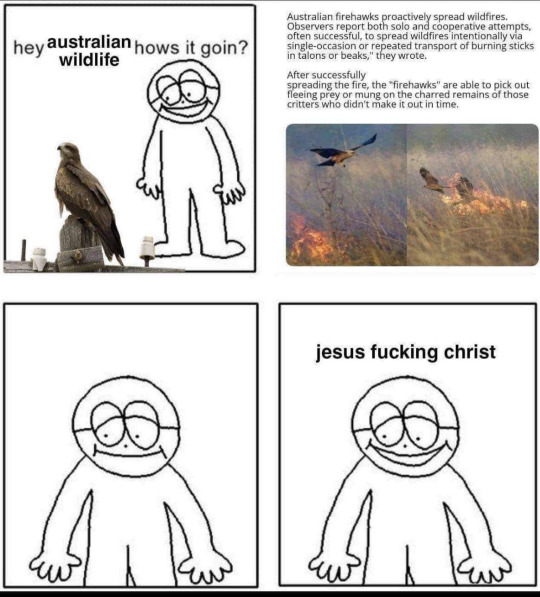
#green memes for ecological fiends#zoology#ecology#bird#hawks#environmental science#biodiversity#conservation biology#conservation#wildlife
28K notes
·
View notes
Text
I love when I'm doing research for an assignment in my conservation biology class and I come across something that was clearly written with barely-contained hatred. Like this paper about Oahu Tree Snails:

(Obviously the fact that the snails are so threatened is not funny, but I must admit, the simmering rage behind these words did make me laugh while reading this.)
here's the link to the paper if anyone's interested. (It's quite old now, published 1990.) Should be accessible without university access or anything, as it's a pdf from a museum collection.
(also, tagging @great-and-small because I feel like this is up your alley.)
785 notes
·
View notes
Text
I wanted to make a post with some links to explain why afforestation (planting trees to stop desertification; the change of environments into deserts) is not always the best approach to take.
So lately on social media there's been a lot of misinformation of like tree planting = always good. But the problem with this approach/view is it gives companies and governments the excuse to use forest monocultures (millions of one or few tree species) to fund logging industries instead of taking the time to develop an ecosystem of native plants.
(Link to real life example:)
youtube
Ecosystems undergo ecological succession where bare land is converted to ecologically productive (lots of different organisms with different roles in the ecosystem, nutritious soil) and biodiverse (lots of different species) land. It also takes a long time for this to happen.
See these:
youtube
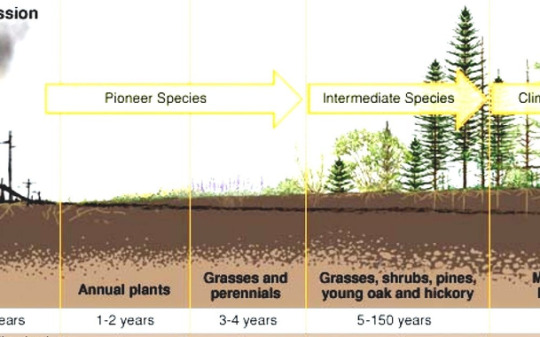
Here's some links a video explaining why just planting trees ultimately doesn't work in the long term if done wrong:
youtube
And here's some links to videos explaining how it can be done right when we actually look at the evolutionary history of the ecosystem and ecology of it and restore it using native species and less rigid attitudes.
youtube
youtube
youtube
youtube
youtube
Habitat restoration is a HUGE branch of conservation biology and is constantly causing disagreements in scientific communities because its a new science and there are so many different branches of biology (e.g. ecology, evolutionary history and ecology, geology, etc) we need to consider and so many old attitudes that need revising in some conservation techniques.
This is only a guide to trees alone in habitat conservation as well, there are so many different habitats other than forest that need to be conserved as well as forests, particularly wetlands which are so abundant in biodiversity and ecosystem services (things ecosystems can do for the world essentially, unfortunately the focus in research can be on what ecosystems can do for us).
I've also not looked much at how this has been done outside of official organisations and I wanna look more at conservation projects ran illegally but I'm bad at finding information lol
#wow i expressed an opinion online without panicking#now to bury my head in the sand if i get criticised#ecology#trees#tree ecology#conservation biology#habitat restoration#rewilding#wildlife#tree conservation#evolutionary ecology#mosscore#forestcore#forests#Youtube
2K notes
·
View notes
Text
Post requested by @sunshine-in-a-bottle !
I haven't got the exact images my professor showed in class, but here are some pretty (in my humble opinion) flies from the family Tabanidae. All images are taken from iNaturalist!

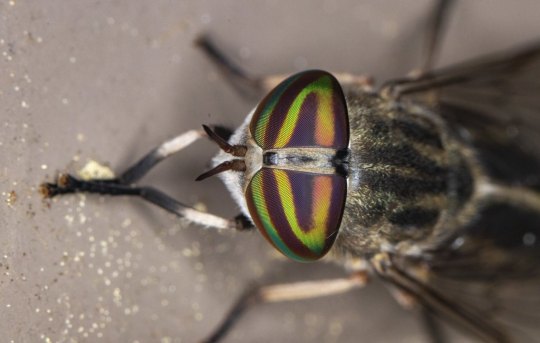
^^ These ones have such beautiful eyes! Don't tell me that you would pass up a pair of sunglasses or ski goggles if the lenses looked like these!

^ This green fellow is vibrant, but I feel that the more "basic" looking ones deserve love as well!

^ Look at how beautiful the stripes are on this one! Such pretty shades of brown and honey-yellow! I also like the two-tone wings!
The diversity that even a single species of Tabanidae can exhibit is great (as made evident by the ID keys we spent a good hour trying to figure out lol). Once you get a close look, I think it is easier to appreciate them :)
#biology#nature#animals#bugs r cool#bugs#insects#flies#biology student#conservation biology#entomology
79 notes
·
View notes
Text
So fucking depressing (hint: for anyone encountering a login wall, firefox will let you read the article by clicking on the page icon on your browser bar called the "Toggle Reader View" button).
Bald cypress are literally thousands of years old in certain places, but essentially climate change and pollution from humans, couple with the destruction of swamplands for much of American history, is finally killing off this incredibly resilient plant that could still teach us so much about how to adapt to our changing environment.
I just... I hate this so much. The reason the swamps and wetlands were targeted was so unnecessary, boiling down to "well, we can't easily use shit from there and it's gross and icky so go ahead and destroy it." Perfectly encapsulates the American perspective, imho.
116 notes
·
View notes
Text
Today is #AudubonDay, commemorating pioneering naturalist and artist John James Audubon who was born #OTD (26 April 1785 - 27 January 1851). I put together this overview of the 5 now extinct and 3 other possibly extinct birds whose images are recorded in The Birds of America for the blog:





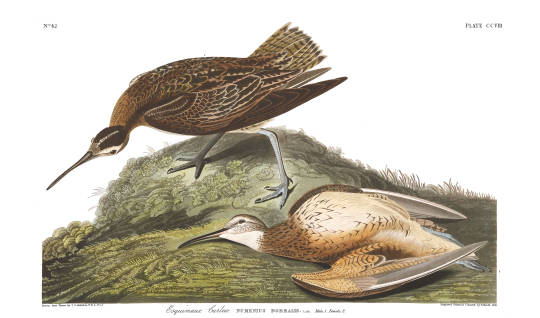


Plate 26: Carolina Parrot, 1827 (Carolina Parakeet, Conuropsis carolinensis)
Plate 62: Passenger Pigeon, 1829 (Passenger Pigeon, Ectopistes migratorius)
Plate 66: Ivory-billed Woodpecker, 1829 (Ivory-billed Woodpecker, Campephilus principalis)
Plate: 185: Bachman’s Warbler, 1834 Bachman’s Warbler, Vermivora bachmanii)
Plate 186: Pinnated Grous, 1834 (Heath Hen, Tympanuchus cupido cupido)
Plate 208: Esquimaux Curlew, 1834 (Eskimo Curlew, Numenius borealis)
Plate 332: Pied Duck, 1836 (Labrador Duck, Camptorhynchus labradorius)
Plate 341: Great Auk, 1836 (Great Auk, Pinguinus impennis)
All plate images courtesy of the John James Audubon Center at Mill Grove, Montgomery County Audubon Collection, and Zebra Publishing. The entire digitized collection is available for viewing and downloading here.
#Audubon Day#Audubon#John James Audubon#bird#birds#birding#ornithology#ornihological illustration#scientific illustration#natural history art#sciart#19th century art#American art#lithograph#extinction#extinct birds#conservation biology#blog post#OTD#birthday post#animals in art
347 notes
·
View notes
Text
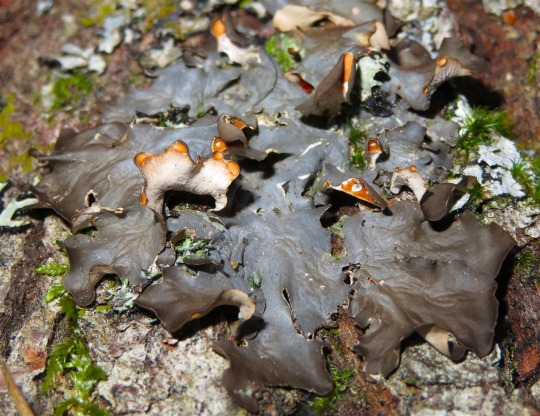



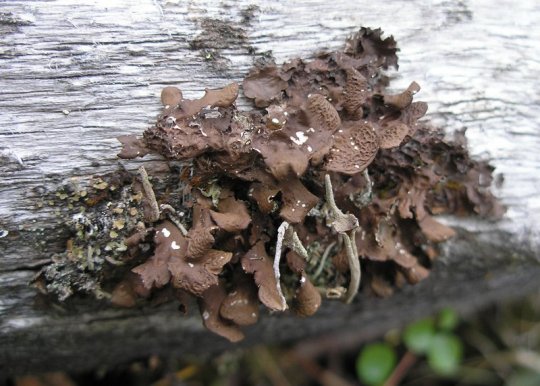

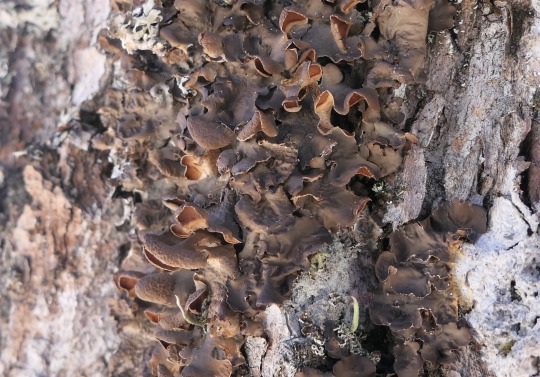
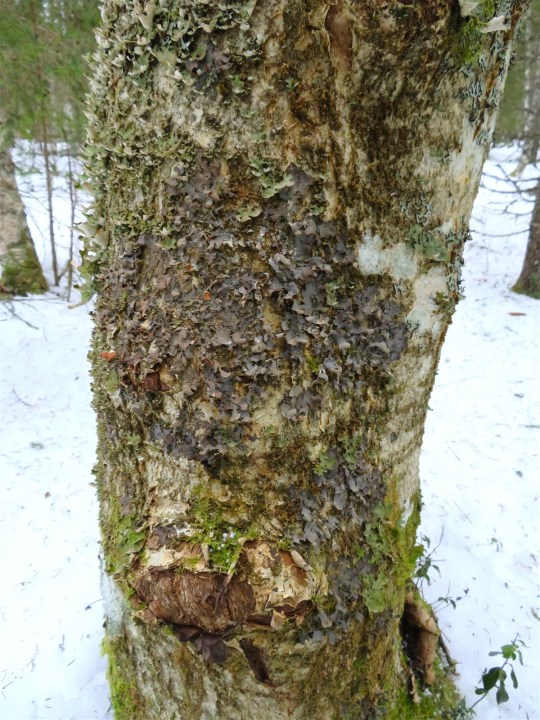
Nephroma bellum
Naked kidney lichen, cat paw lichen
This foliose lichen has a loose, fragmenting or rosette-forming thallus that grows up to 8-10 cm in diameter. It has a smooth, slightly pubescent, gray to brown upper surface pale and a pale brown to yellow lower surface lacking rhizines. It commonly produces marginal, downward-facing, kidney-shaped apothecia which have a brown disc and prominent, thalloid margin. It has a cyanobacterial photobiont. N. bellum grows on mossy trees and rocks, and is found in humid canyons and mid-high elevation spruce-fir forests in Europe, Africa, and North America. It is considered "threatened" throughout its habitat range in Europe, where its range has decreased due to deforestation, reduction of old-growth forest, and pollution.
images: source | source
info: source | source | source | source
#lichen#lichens#lichenology#lichenologist#mycology#ecology#fungi#biology#nature#bryology#symbiosis#symbiotic organisms#cyanobacteria#fungus#forest#forestry#see the forest for the lichens#conservation biology#I'm lichen it#lichen a day#daily lichen post#Nephroma bellum#Nephroma#Iichen subscribe#go outside#take a hike#look for lichens
59 notes
·
View notes
Link
Global animal populations are declining, and we've got limited time to try to fix it.
That's the upshot of a new report from the World Wildlife Fund and the Zoological Society of London, which analyzed years of data on thousands of wildlife populations across the world and found a downward trend in the Earth's biodiversity.
According to the Living Planet Index, a metric that's been in existence for five decades, animal populations across the world shrunk by an average of 69% between 1970 and 2018.
Not all animal populations dwindled, and some parts of the world saw more drastic changes than others. But experts say the steep loss of biodiversity is a stark and worrying sign of what's to come for the natural world.
"The message is clear and the lights are flashing red," said WWF International Director General Marco Lambertini.
Continue Reading.
443 notes
·
View notes
Text
Osprey in the lower Chesapeake Bay have been experiencing nest failure, leading to a reproductive rate comparable to during the DDT crisis. But unlike during DDT, reproductive failure occurs not at hatching but while young are in the nest.
The culprit? Overfishing of menhaden (a fish species), which Osprey depend on in the lower, more saline portion of the Bay.
"The current fish availability is not high enough to allow osprey to reproduce sustainably. Their young are starving in the nest – most within the first week after hatching."
The menhaden fishery is controversial. A popular bait fish for striped bass and other sportfishing, it is also crucial to many birds of prey along the coast.
In contrast to the lower Bay, Osprey in the upper bay rely on a mix of catfish, shad, and other species. These Osprey are experiencing stable population growth rates.
Bald Eagles, which often kleptoparasitize Ospreys, are also doing well. They are at total capacity in the region: essentially every possible territory is occupied.
Check out the linked article by the Center for Conservation Biology for more information.
#osprey#conservation biology#wildlife#Chesapeake bay#fisheries#pandion haliaetus#pandion#pandionidae#accipitriformes#article#menhaden
114 notes
·
View notes
Text
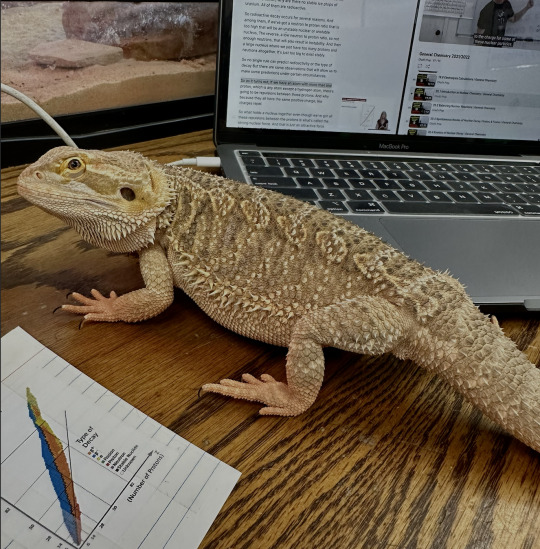
Karen the bearded dragon enjoys helping me study. She definitely thinks she is better than me, but she's good moral support🤎
Keep at it and finish your semester strong!!
#notes#pre vet#studyblr#pre veterinary medicine#animal science#adhd#veterinary#study#veterinary medicine#chemistry#conservation biology#ecology major#bearded dragon#pets of tumblr
46 notes
·
View notes
Text
"Chicago’s 82-story Aqua Tower appears to flutter with the wind. Its unusual, undulating facade has made it one of the most unique features of Chicago’s skyline, distinct from the many right-angled glass towers that surround it.
In designing it, the architect Jeanne Gang thought not only about how humans would see it, dancing against the sky, but also how it would look to the birds who fly past. The irregularity of the building’s face allows birds to see it more clearly and avoid fatal collisions. “It’s kind of designed to work for both humans and birds,” she said.
As many as 1 billion birds in the US die in building collisions each year. And Chicago, which sits along the Mississippi Flyway, one of the four major north-south migration routes, is among the riskiest places for birds. This year, at least 1,000 birds died in one day from colliding with a single glass-covered building. In New York, which lies along the Atlantic Flyway, hundreds of species traverse the skyline and tens of thousands die each year.
As awareness grows of the dangers posed by glistening towers and bright lights, architects are starting to reimagine city skylines to design buildings that are both aesthetically daring and bird-safe.
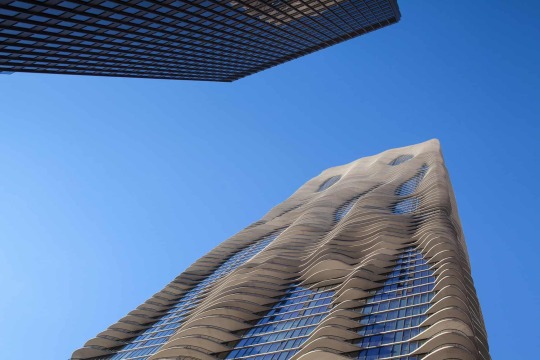
Pictured: Chicago's Aqua Tower was designed with birds in mind.
Some are experimenting with new types of patterned or coated glass that birds can see. Others are rethinking glass towers entirely, experimenting with exteriors that use wood, concrete or steel rods. Blurring lines between the indoors and outdoors, some architects are creating green roofs and facades, inviting birds to nest within the building.
“Many people think about bird-friendly design as yet another limitation on buildings, yet another requirement,” said Dan Piselli, director of sustainability at the New York-based architecture firm FXCollaborative. “But there are so many design-forward buildings that perfectly exemplify that this doesn’t have to limit your design, your freedom.”
How modern buildings put birds in danger
For Deborah Laurel, principal in the firm Prendergast Laurel Architects, the realization came a couple of decades ago. She was up for an award for her firm’s renovation of the Staten Island Children’s Museum when the museum’s director mentioned to her that a number of birds had been crashing into the new addition. “I was horrified,” she said.
She embarked on a frenzy of research to learn more about bird collisions. After several years of investigation, she found there was little in the way of practical tips for architects, and she teamed up with the conservation group NYC Audubon, to develop a bird-safe building guide.
The issue, she discovered, was that technological and architectural advancements over the last half-century had in some ways transformed New York City – and most other US skylines and suburbs – into death traps for birds...
At certain times of day, tall glass towers almost blend into the sky. At other times, windows appear so pristinely clear that they are imperceptible to birds, who might try to fly though them. During the day, trees and greenery reflected on shiny building facades can trick birds, whereas at night, brightly lit buildings can confuse and bewilder them...

Pictured: A green roof on the Javits Convention Center serves as a sanctuary for birds.
The changes that could save avian lives
About a decade ago, Piselli’s firm worked on a half-billion-dollar renovation of New York’s Jacob K Javits Convention Center, a gleaming glass-clad space frame structure that was killing 4,000-5,000 birds a year. “The building was this black Death Star in the urban landscape,” Piselli said.
To make it more bird friendly, FXCollaborative (which was then called FXFowle) reduced the amount of glass and replaced the rest of it with fritted glass, which has a ceramic pattern baked into it. Tiny, textured dots on the glass are barely perceptible to people – but birds can see them. The fritted glass can also help reduce heat from the sun, keeping the building cooler and lowering air conditioning costs. “This became kind of the poster child for bird-friendly design in the last decade,” Piselli said.
The renovation also included a green roof, monitored by the NYC Audubon. The roof now serves as a sanctuary for several species of birds, including a colony of herring gulls. Living roofs have since become popular in New York and other major cities, in an inversion of the decades-long practice of fortifying buildings with anti-bird spikes. In the Netherlands, the facade of the World Wildlife Fund headquarters, a futuristic structure that looks like an undulating blob of mercury, contains nest boxes and spaces for birds and bats to live.
The use of fritted glass has also become more common as a way to save the birds and energy.
Earlier this year, Azadeh Omidfar Sawyer, an assistant professor in building technology in the Carnegie Mellon School of Architecture, working with student researchers, used open-source software to help designers create bespoke, bird-friendly glass patterns. A book of 50 patterns that Sawyer published recently includes intricate geometric lattices and abstract arrays of lines and blobs. “Any architect can pick up this book and choose a pattern they like, or they can customize it,” she said.
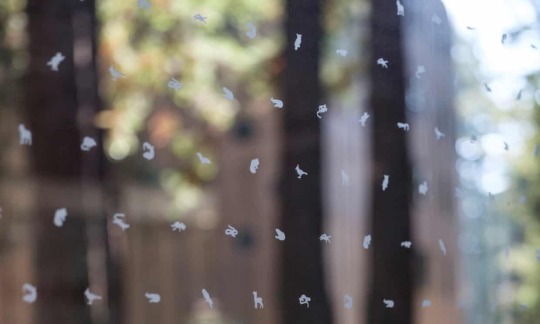
Pictured: The fritted glass used in Studio Gang’s expansion of Kresge College at the University of California, Santa Cruz, depicts the animals in the local ecosystem.
Builders have also been experimenting with UV-printed patterns, which are invisible to humans but perceptible to most birds. At night, conservationists and architects are encouraging buildings turn off lights, especially during migration season, when the bright glow of a city skyline can disorient birds.
And architects are increasingly integrating screens or grates that provide shade as well as visibility for birds. The 52-floor New York Times building, for example, uses fritted glass clad with ceramic rods. The spacing between the rods increases toward the top of the building, to give the impression that the building is dissolving into the sky.
Gang’s work has incorporated structures that can also serve as blinds for birders, or perches from which to observe nature. A theater she designed in Glencoe, Illinois, for example, is surrounded by a walking path made of a wood lattice, where visitors can feel like they’re up in the canopy of trees.

Pictured: The Writers Theatre, designed by Studio Gang, includes a walking path encased in wood lattice.
Rejecting the idea of the iridescent, entirely mirrored-glass building, “where you can’t tell the difference between the habitat and the sky”, Gang aims for the opposite. “I always tried to make the buildings more visible with light and shadow and geometry, to have more of a solid presence,” she said.
Gang has been experimenting with adding bird feeders around her own home in an effort to reduce collisions with windows, and she encourages other homeowners to do the same.
“I’ve found that birds slow down and stop at feeders instead of trying to fly through the glass,” she said.
While high-rise buildings and massive urban projects receive the most attention, homes and low-rise buildings account for most bird collision deaths. “The huge challenge is that glass is everywhere.” said Christine Sheppard, who directs the glass collisions program at the American Bird Conservancy (ABC). “It’s hard to know what I know and not cringe when I look at it.”
Tips for improving your own home include using stained glass or patterned decals that can help birds see a window, she said. ABC has compiled a list of window treatments and materials, ranked by how bird-safe they are.
Whether they’re large or small, the challenge of designing buildings that are safe for birds can be “liberating”, said Gang, who has become an avid birdwatcher and now carries a pair of binoculars on her morning jogs. “It gives you another dimension to try to imagine.”"
-via The Guardian, December 27, 2023
#conservation#birds#avian#ornithology#new york city#chicago#united states#architecture#green architecture#conservation biology#construction#sustainability#glass#glass windows#skyscraper#cityscape#buildings#bird conservation#birdwatching#good news#hope#“hey mc why is this post so in depth and full of pics compared to what you usually post” you ask#great question#the answer is bc I like architecture a lot#...well I like the kinds of architecture I like a lot lol#bauhaus can fight me tbh#but sustainable architecture is awesome#also this article actually came with a bunch of pics#which yknow most of them don't#cw animal death
1K notes
·
View notes
Text
I don’t know how to properly put into words how I feel about the nightingale. It’s not only an expression of Crowley and Aziraphale’s love for each other but also their love for the world. They love the world so much and love humanity so much that they stood up against a plan millions of years in the making and impossible odds just to save it. Facing down a fight they are sure they cannot win, betraying their very nature just to save this little planet that they’ve come to adore and the life they’ve built with each other. Loving something and someone so much it literally tears apart and rewrites the fabric of reality.
Look — I’m a conservation biologist. I’m also a writer. Both of these are innate to who I am, I couldn’t possibly be anything else. I love the earth more than I think humans are meant to love anything. Sometimes I feel like the pure power of how ferociously I care about this little blue marble is going to burn me up. I know exactly what it’s like to stare into what feels like an insurmountable battle and say, “No. You will not destroy this. I will not let you.” I know what it’s like to be so unwilling to give it up, so unwilling to lie down and admit defeat because you feel the love heavy in your chest, and you somehow know that means it’s not supposed to disappear. Their nightingale gives me hope that if I keep loving as hard as I do, maybe, just maybe, that love will be enough to rewrite our own reality. Just… thank you, @neil-gaiman. Thank you Terry. What a beautiful metaphor you created, all those years ago.
#good omens#nightingale#a nightingale sang in berkeley square#the nightingale#good omens 2#good omens meta#proframbles#i am really going through it here#aziracrow#ineffable husbands#the ineffable plan#ineffable#neil gaiman#terry pratchett#i'm so emotional#conservation biology#meta#writing
51 notes
·
View notes
Text
prairie posting



grasslands are endangered ecosystems! all over the world, just fractions of percentages are left of each kind. find out what grasslands exist near you and grow some local plants! it really helps your ecosystem and its good for the soul :)
22 notes
·
View notes
Text
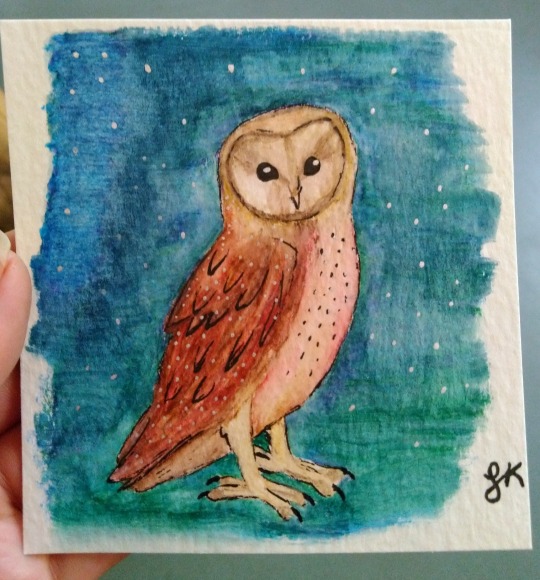
My first attempt at watercolour with a lil barn owl! This was the species that got me really interested in conservation, and I am forever thankful that I pursued it!
#art#mine#watercolour#owls#animals#animal art#bird art#barn owl#wildlife art#nature#nature art#tyto alba#conservation biology#conservation#wildlife#ornithology#birds
64 notes
·
View notes
